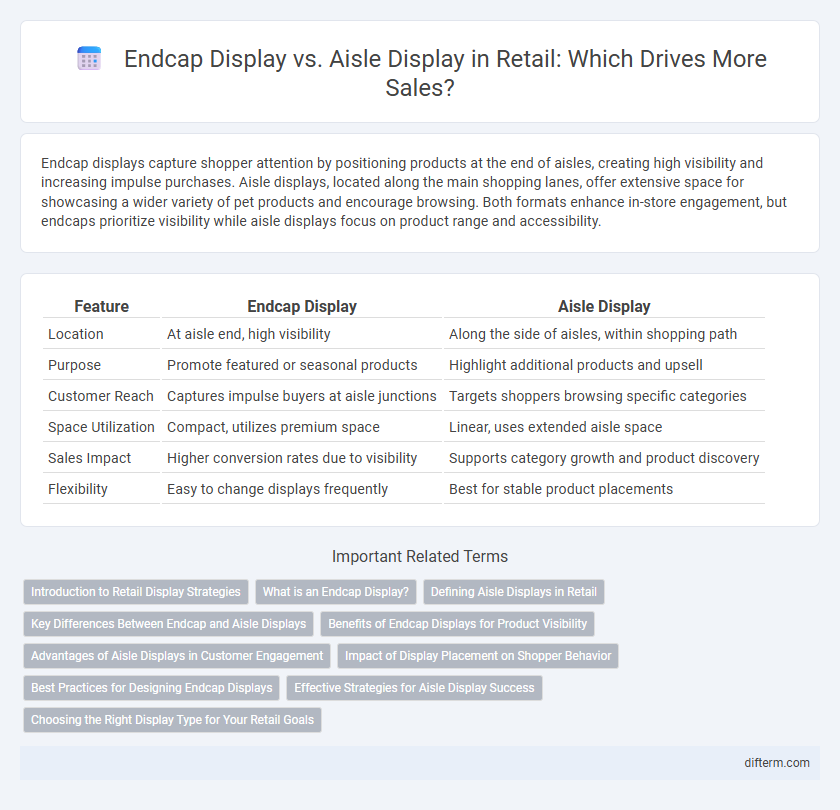Endcap displays capture shopper attention by positioning products at the end of aisles, creating high visibility and increasing impulse purchases. Aisle displays, located along the main shopping lanes, offer extensive space for showcasing a wider variety of pet products and encourage browsing. Both formats enhance in-store engagement, but endcaps prioritize visibility while aisle displays focus on product range and accessibility.
Table of Comparison
| Feature | Endcap Display | Aisle Display |
|---|---|---|
| Location | At aisle end, high visibility | Along the side of aisles, within shopping path |
| Purpose | Promote featured or seasonal products | Highlight additional products and upsell |
| Customer Reach | Captures impulse buyers at aisle junctions | Targets shoppers browsing specific categories |
| Space Utilization | Compact, utilizes premium space | Linear, uses extended aisle space |
| Sales Impact | Higher conversion rates due to visibility | Supports category growth and product discovery |
| Flexibility | Easy to change displays frequently | Best for stable product placements |
Introduction to Retail Display Strategies
Endcap displays maximize product visibility by positioning merchandise at the end of aisles, capturing shopper attention through high foot traffic and impulse-buy opportunities. Aisle displays, integrated within the shopping corridor, create continuous product engagement, encouraging comparison and exploration. Both strategies optimize shelf space and influence consumer behavior by enhancing product accessibility and store navigation.
What is an Endcap Display?
An Endcap Display is a retail merchandising fixture positioned at the end of store aisles, designed to capture shopper attention and increase product visibility. This strategic placement leverages high foot traffic areas, promoting special offers or new products effectively compared to traditional aisle displays. Retailers often use endcaps to boost impulse purchases and maximize sales for featured items.
Defining Aisle Displays in Retail
Aisle displays in retail are strategically positioned fixtures located within the aisles to maximize product visibility and accessibility for shoppers navigating store pathways. These displays are designed to engage customers by showcasing promotional items, seasonal products, or high-demand merchandise, enhancing impulse purchases and increasing overall sales. Unlike endcap displays which occupy the ends of aisles, aisle displays create continuous exposure along the shopping route, driving foot traffic deeper into the store.
Key Differences Between Endcap and Aisle Displays
Endcap displays are positioned at the end of aisles, maximizing product visibility and attracting high foot traffic, while aisle displays run along the length of the aisles, facilitating product browsing and impulse purchases. Endcaps often feature promotional or seasonal items to boost sales, whereas aisle displays provide continuous product exposure to shoppers navigating the store. Space utilization and customer engagement differ as endcaps capitalize on blocking sightlines, while aisle displays emphasize product accessibility within shopping flow.
Benefits of Endcap Displays for Product Visibility
Endcap displays significantly boost product visibility by positioning items at the end of aisles where shopper traffic naturally converges. This strategic placement increases product exposure compared to standard aisle displays, leading to higher impulse buys and improved sales performance. Retailers benefit from endcap displays by enhancing brand prominence and capturing customer attention at key decision points.
Advantages of Aisle Displays in Customer Engagement
Aisle displays enhance customer engagement by positioning products within high-traffic pathways, increasing visibility and impulse purchases. Their strategic placement allows for interactive and larger product arrangements, creating a more immersive shopping experience compared to endcap displays. This results in longer customer dwell time and higher conversion rates due to easy access and prominent product exposure.
Impact of Display Placement on Shopper Behavior
Endcap displays significantly increase product visibility and impulse purchases by capturing shopper attention at high-traffic aisle intersections, often driving up to 30% higher sales compared to aisle displays. Aisle displays, positioned along shopping pathways, encourage product discovery but generally yield lower engagement due to competition with surrounding merchandise. Strategic placement of endcap displays influences shopper flow and dwell time, leading to enhanced brand exposure and elevated purchase intent in retail environments.
Best Practices for Designing Endcap Displays
Endcap displays should prioritize high-visibility placement at store entrances or main aisle intersections to capture maximum shopper attention and drive impulse purchases. Effective design incorporates clear signage, product organization by category or theme, and eye-level shelving to enhance product accessibility and appeal. Incorporating complementary products and seasonal promotions further boosts engagement and encourages cross-selling opportunities.
Effective Strategies for Aisle Display Success
Aisle displays boost product visibility by targeting high-traffic pathways, increasing impulse purchases through strategic placement and eye-level positioning. Utilizing bold signage, thematic merchandising, and clear call-to-actions enhances shopper engagement and drives sales. Regular rotation and analysis of aisle display performance ensure alignment with consumer behavior and seasonal trends, maximizing return on investment.
Choosing the Right Display Type for Your Retail Goals
Endcap displays maximize visibility by positioning products at the end of aisles, driving impulse purchases and increasing sales of promotional items. Aisle displays, placed along the shopping path, provide continuous product exposure and encourage browsing, ideal for brands aiming to reinforce brand presence. Selecting the appropriate display type depends on retail goals such as boosting immediate sales or enhancing long-term brand awareness.
Endcap Display vs Aisle Display Infographic

 difterm.com
difterm.com